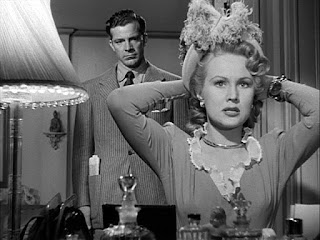Reflecting on this day last night, an old movie came to mind that I haven't seen in years. The Best Years of Our Lives is one of my favorite movies, perfect for Memorial Day or any day. I've posted the original November 22, 1946 New York Times movie review by Bosley Crowther below:
It is seldom that there comes a motion picture which can be wholly and enthusiastically endorsed not only as superlative entertainment but as food for quiet and humanizing thought. Yet such a one opened at the Astor last evening. It is "The Best Years of Our Lives." Having to do with a subject of large moment—the veteran home from war—and cut, as it were, from the heart-wood of contemporary American life, this film from the Samuel Goldwyn studio does a great deal more, even, than the above. It gives off a warm glow of affection for everyday, down-to-earth folks.
 |
| Virginia Mayo's character is such a tart! |
These are some fancy recommendations to be tossing boldly forth about a film which runs close to three hours and covers a lot of humanity in that time. Films of such bulky proportions usually turn out the other way. But this one is plainly a labor not only of understanding but of love from three men who put their hearts into it—and from several others who gave it their best work. William Wyler, who directed, was surely drawing upon the wells of his richest talent and experience with men of the Air Forces during the war. And Robert E. Sherwood, who wrote the screen play from a story by MacKinlay Kantor, called "Glory for Me," was certainly giving genuine reflection to his observations as a public pulse-feeler these past six years. Likewise, Mr. Goldwyn, who produced, must have seen this film to be the fulfillment of a high responsibility. All their efforts are rewarded eminently.
For "The Best Years of Our Lives" catches the drama of veterans returning home from war as no film—or play or novel that we've yet heard of—has managed to do. In telling the stories of three veterans who come back to the same home town—one a midde-aged sergeant, one an air officer and one a sailor who has lost both hands—it fully reflects the delicate tensions, the deep anxieties and the gnawing despairs that surely have been experienced by most such fellows who have been through the same routine. It visions the overflowing humors and the curious pathos of such returns, and it honestly and sensitively images the terrible loneliness of the man who has been hurt—hurt not only physically but in the recesses of his self-esteem.
 |
| This scene always makes me teary. |
Not alone in such accurate little touches as the first words of the sergeant's joyful wife when he arrives home unexpectedly, "I look terrible!" or the uncontrollable sob of the sailor's mother when she first sees her son's mechanical "hands" is this picture irresistibly affecting and eloquent of truth. It is in its broader and deeper understanding of the mutual embarrassment between the veteran and his well-intentioned loved ones that the film throws its real dramatic power.Especially in the readjustments of the sailor who uses prosthetic "hooks" and of the airman who faces deflation from bombardier to soda-jerker is the drama intense. The middle-aged sergeant finds adjustment fairly simple, with a wife, two grown-up kids and a good job, but the younger and more disrupted fellows are the ones who really get it in the teeth. In working out their solutions Mr. Sherwood and Mr. Wyler have achieved some of the most beautiful and inspiring demonstrations of human fortitude that we have had in films.
 |
| Myrna Loy and Frederic March are great together! |
And by demonstrating frankly and openly the psychological blocks and the physical realities that go with prosthetic devices they have done a noble public service of great need. It is wholly impossible—and unnecessary—to single out any one of the performers for special mention. Fredric March is magnificent as the sergeant who breaks the ice with his family by taking his wife and daughter on a titanic binge. His humor is sweeping yet subtle, his irony is as keen as a knife and he is altogether genuine. This is the best acting job he has ever done. Dana Andrews is likewise incisive as the Air Forces captain who goes through a gruelling mill, and a newcomer, Harold Russell, is incredibly fine as the sailor who has lost his hands. Mr. Russell, who actually did lose his hands in the service and does use "hooks," has responded to the tactful and restrained direction of Mr. Wyler in a most sensitive style.
As the wife of the sergeant, Myrna Loy is charmingly reticent and Teresa Wright gives a lovely, quiet performance as their daughter who falls in love with the airman. Virginia Mayo is brassy and brutal as the latter's two-timing wife and Cathy O'Donnell, a new, young actress, plays the sailor's fiancée tenderly. Hoagy Carmichael, Roman Bohnen and Ray Collins will have to do with a warm nod. For everyone gives a "best" performance in this best film this year from Hollywood.
One great movie! Have you ever seen it?
Thanks for visiting and have a great week!







